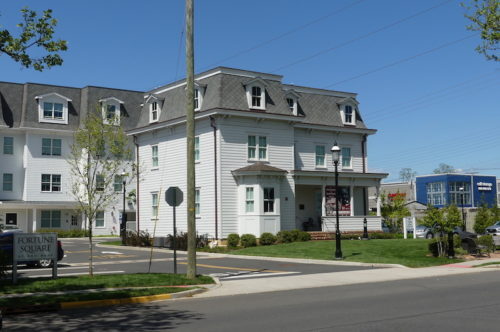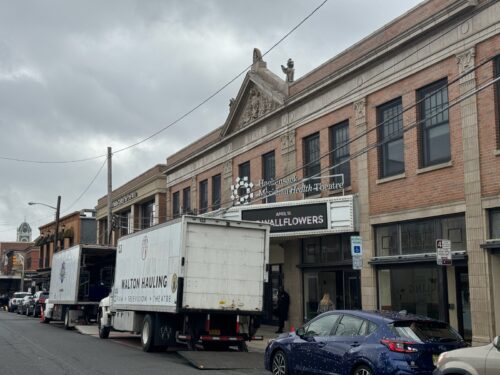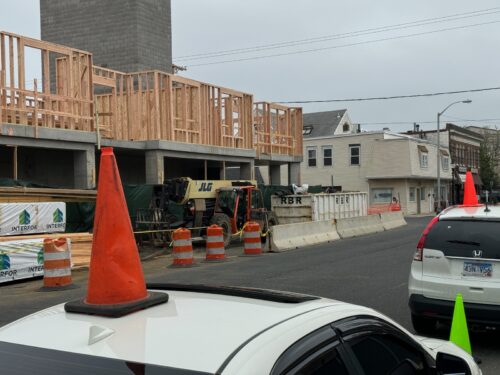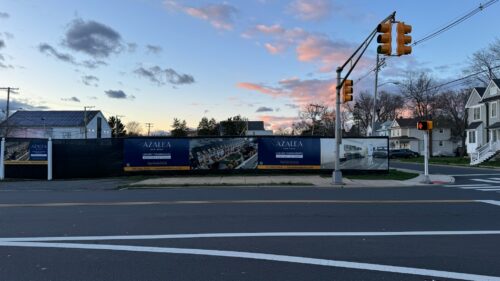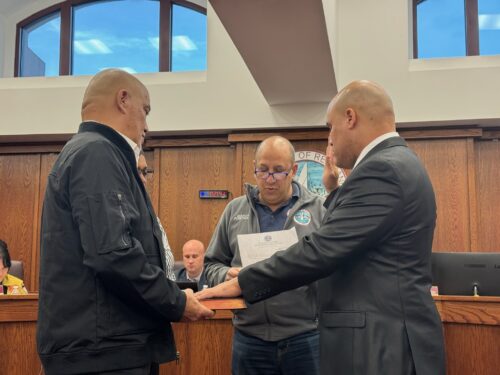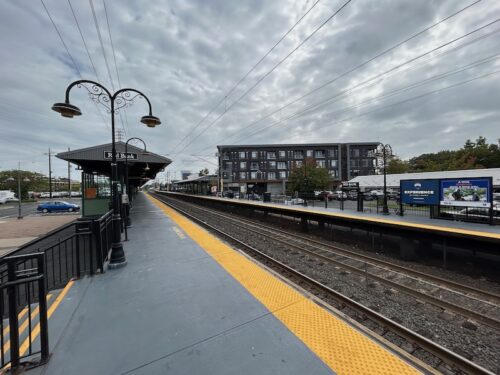 Denholtz’s Rail at Red Bank multiuse project, as seen from a train station platform, would be joined by more development if the Transit Village plan advances. (Photo by John T. Ward. Click to enlarge.)
Denholtz’s Rail at Red Bank multiuse project, as seen from a train station platform, would be joined by more development if the Transit Village plan advances. (Photo by John T. Ward. Click to enlarge.)
By JOHN T. WARD
A possible “transit village” of higher-density housing around Red Bank’s train station got its fullest airing yet Thursday night.
Next, the governing body will have to decide whether to put the the idea on the rails with a study.
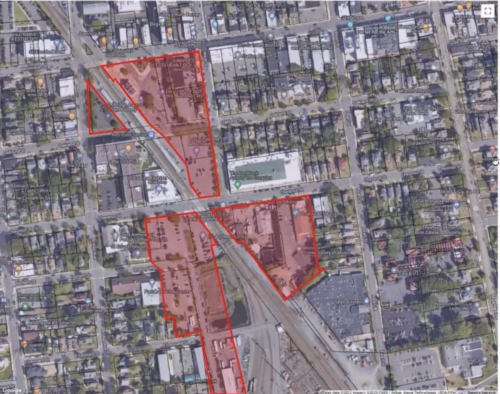 A map showing some of the properties suggested for a study area included station parking lots, Denholtz holdings and the borough publc works yard and an adjoining site, to the east (right) of the rail line. (Screen grab. Click to enlarge.)
A map showing some of the properties suggested for a study area included station parking lots, Denholtz holdings and the borough publc works yard and an adjoining site, to the east (right) of the rail line. (Screen grab. Click to enlarge.)
Appearing at the council’s sole meeting scheduled for November, Community Planning Director Shawna Ebanks outlined the steps involved in pursuing a Transit Village designation from New Jersey Transit and the state Department of Transportation.
It may require the adoption of an “Area in Need of Redevelopment” ordinance, she said. But first, the council should direct the planning board to conduct a preliminary study of the area through a consultant Ebanks said.
The properties she suggested studying were “brought to our attention” by NJT and Denholtz Properties, said Ebanks. All are owned by NJT or Denholtz except for the borough public works yard and an adjoining property owned by the Count Basie Center for the Arts on Chestnut Street, she said.
Denholtz is based in the Rail, a 57-unit multiuse project it opened two years ago on Chestnut Street, abutting the North Jersey Coast Line. As reported by redbankgreen in March, 2022, the company has plans for a massive development on four NJT parking lots east and south of the station as well as its own holdings along the rail line.
They are:
• The Mayo Auto Service site on Monmouth Street and three adjoining lots extending to West and Oakland streets.
• A 95-space lot on Herbert Street that Denholtz has owned for six years.
• The NJ Transit parking lot alongside the east side of the station to West Street.
• Two adjoining NJ Transit lots on Chestnut Street, opposite Denholtz’s headquarters at 116 Chestnut.
Those plans are dependent on the borough designating the around the station as redevelopment area, company CEO Steve Denholtz told redbankgreen. “There’s no way under existing zoning that we could develop it,” he said at the time.
Deputy Mayor Kate Triggiano asked if the borough was obligated to partner with Denholtz, given that NJT has selected the company to redevelop its holdings here.
“It is at the borough’s discretion if they want to still authorize [Denholtz] to be the redeveloper, because this is the governing body’s option,” Ebanks said. “But it’s Transit’s property, most of it, that’s there, and they have the option of choosing who they want to give their property to who they want.”
Responding to a question from Councilmember Ben Forest about who has “final say” over an NJT project, Ebanks said the state agency has to build “according to that plan” adopted by Red Bank. Any plan that deviates “would possibly need a variance,” she said.
On its website, New Jersey Transit lists “The Centre at Red Bank” among its upcoming Transit-Oriented Development projects, and identifies Denholtz as the developer.
Twenty percent of the apartments will be dedicated as affordable housing, the website says, adding, “the development will include beautification of the station area, historic preservation of the Dan O’Hern Train Station, improved circulation and station access, and enhanced social and environmental sustainability, with a new public square and increased tree canopy and green space throughout.”
Among the issues that emerged as a possible sticking point was the question of payment-in-lieu-of-taxes. agreements, or PILOTs.
Forest, a former president of the borough school board, said he was concerned that a PILOT would adversely affect the district.
“I want to see our schools get proper funding,” he said.
“That’s all up to the governing body, whether you grant a PILOT,” said Ebanks. “Just because you designate an area in need of redevelopment and you have a redevelopment plan does not mean you have to give one.”
Whether or not one is granted, the borough is obligated to forward to the school districts tax monies collected toward their approved budgets, Ebanks said.
But if a plan calls for 20-percent affordable housing, “that has to be subsidized in some manner by the market-rate units,” said borough Attorney Greg Cannon. “The tradeoff for affordable housing is either increase density or a PILOT incentive for the same [unintelligible] as the deed restriction.”
According to its website, Denholtz has a PILOT agreement with Asbury Park to build a 125-unit multiuse project, dubbed the Rail at Asbury Park, on propetry it owns on Cookman Avenue facing the city’s train station. With 80 percent of the apartments to be rented at market rates, Denholtz has “an affordable obligation” on the remaining 20 percent and “will benefit from a 30-year PILOT Program (Payment in Lieu of Taxes), mitigating any tax assessment risk and creating substantial savings in operating expenses,” the site says.
Greg Fitzgerald, of Locust Avenue, was among several residents in the audience who praised the presentation as the start of a possible transformation of the area.
“This is great,” he said, adding that the study could lead to a plan “that might yield things changing, that might yield a transit village designation. This is just, ‘do we want to explore it futher?'”
But Amy Goldsmith, also of Locust Avenue, advised caution.
The Rail “doesn’t look anything like my neighborhood,” said Goldsmith, who is married to Forest. “”I’m concerned that it’s a lot of cement, it’s a lot of bricks, it creates a wall, not a connection.”
“I’m not saying yes, I’m not saying no, I’m saying we need to be mindful” of the impacts, she said.
But Jimmy Dark, of West Sunset Avenue, said large-scale development of the area would add to existing traffic.
“It’s too congested now,” he said. “It’s better off leaving it like it is.”
Forest said he was “leaning toward” initiating the study, though he added that “New Jersey Transit is not on my list of really well-run or well-funded agencies,” and suggested an NJT official be invited in to discuss the matter.
Forest said the inclusion of the public works site was appropriate, as it meets at least one of the criteria for Area in Need of Redevelopment designation: it’s cleary “blighted,” he said.
Ebanks said that by including the site in a redevelopment plan, “we’re hoping that the influence kind of goes over to the public works site.”
“It’s not that the borough’s going to sell off the public works, because it’s definitely well needed, but it can help make some improvements to it,” she said. Ebanks cited the rehabilitation of a long-unused former municipal building in South Orange, now private property, as an example.
Do you value the news coverage provided by redbankgreen? Please become a financial supporter if you haven’t already. Click here to set your own level of monthly or annual contribution.


